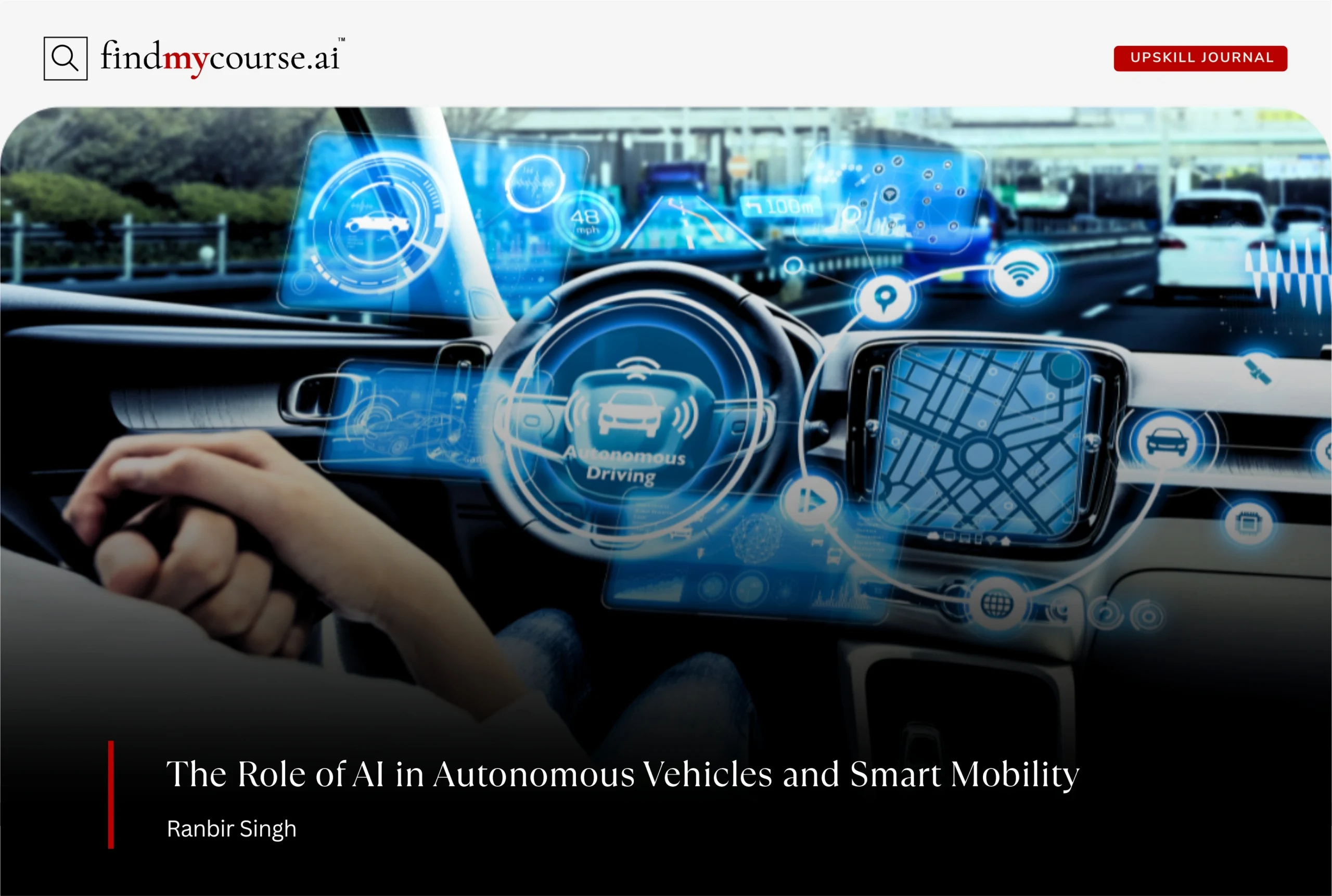The rapid evolution of artificial intelligence (AI) has fueled some of the most transformative innovations of our time. Among these, AI in autonomous vehicles stands out as a technological marvel that’s redefining transportation, mobility, and safety on our roads. In 2025, the vision of cars driving themselves is no longer futuristic—it’s happening now. From AI-driven sensors and real-time data processing to intelligent decision-making systems, the synergy between AI and automotive technology is steering us toward a smarter, safer, and more efficient world.
For professionals eager to stay ahead in this evolving landscape, understanding how AI shapes autonomous systems isn’t just fascinating—it’s a powerful opportunity to upskill and future-proof their careers.
Understanding the Core: What Is an Autonomous Vehicle?
Before diving deeper, it’s essential to clarify what is an autonomous vehicle. Simply put, it’s a self-driving car capable of navigating without direct human control. Using a blend of sensors, cameras, radar, LiDAR, GPS, and advanced AI algorithms, these vehicles can perceive their surroundings, make decisions, and execute driving actions—just like a human driver.
Autonomous vehicles are typically classified across five levels of automation, ranging from Level 1 (driver assistance) to Level 5 (full automation). At the highest level, a car can handle every aspect of driving—no steering wheel, no pedals, no human intervention required.
Yet, what makes this autonomy possible isn’t just hardware. It’s the intelligence—the AI systems—that interpret and act on millions of data points per second.
The Brain Behind the Wheel: How Is AI Used in Autonomous Vehicles?
AI acts as the central nervous system of self-driving cars—an intricate digital brain that senses, interprets, learns, and acts. But how is AI used in autonomous vehicles exactly? The answer lies in a series of intelligent processes that work together in real time to ensure safety and precision on the road. Let’s break it down step by step.
1. Perception: Teaching Cars to “See” the World
Every journey begins with perception. For a vehicle to drive autonomously, it must first understand its surroundings. AI achieves this through a powerful combination of sensors, cameras, LiDAR, radar, and ultrasonic systems.
Using computer vision and deep learning models, AI processes raw visual and spatial data to identify objects such as:
- Pedestrians crossing the street
- Nearby vehicles and their speeds
- Traffic lights, road markings, and signage
- Obstacles, animals, and environmental hazards
This perception layer works like a human’s eyes and brain working together—recognizing patterns, detecting motion, and creating a 360-degree awareness map in milliseconds.
2. Localization and Mapping: Knowing Exactly Where the Vehicle Is
Once the environment is perceived, the vehicle must determine its precise position within it. Through simultaneous localization and mapping (SLAM), AI compares sensor data with high-definition maps to understand its exact location on the road—accurate to within centimeters.
This allows the car to:
- Align itself within lanes
- Adjust for curves, turns, and intersections
- Recognize temporary changes such as construction zones or detours
Localization is crucial, especially in complex urban settings where GPS signals alone may be unreliable.
3. Prediction: Anticipating What Happens Next
Driving safely requires more than seeing—it requires foresight. This is where the prediction layer of AI comes in. By analyzing the motion patterns, speed, and trajectories of nearby objects, AI predicts what other road users might do next.
For example:
- A cyclist slightly veering left might indicate a turn.
- A pedestrian stepping off the curb may soon cross.
- A car signaling right might merge into another lane.
AI models use massive datasets and probabilistic algorithms to estimate these behaviors, helping the vehicle act proactively rather than reactively.
4. Decision-Making: Choosing the Safest and Smartest Path
Once the vehicle perceives and predicts, it must decide what to do next—this is the decision-making stage. Here, AI uses reinforcement learning and neural networks to weigh multiple options and select the safest, most efficient maneuver.
It decides when to:
- Accelerate or brake
- Change lanes or overtake
- Stop at traffic lights or cross intersections
- Navigate around obstacles or reroute due to congestion
For instance, Tesla’s Full Self-Driving (FSD) and Waymo’s Driver AI demonstrate how machine learning enables adaptive decision-making—improving continuously through millions of real-world driving hours.
5. Control and Execution: Bringing AI’s Decisions to Life
Once decisions are made, the control system translates them into physical actions—steering, braking, and accelerating—through highly responsive actuators. This process happens in fractions of a second, ensuring smooth and precise vehicle movement.
Advanced feedback loops constantly monitor whether actions align with AI’s intended path. If an unexpected event occurs (like debris on the road), the system recalibrates instantly, executing new maneuvers to maintain safety and stability.
6. Continuous Learning: Getting Smarter with Every Mile
Unlike traditional software that’s static, AI systems in autonomous vehicles continuously learn and evolve. Through machine learning pipelines, data from millions of driving miles is analyzed to refine models, correct errors, and improve prediction accuracy.
This continuous feedback cycle enables the vehicle to handle new conditions—like unusual weather, unfamiliar roads, or complex traffic scenarios—better over time. Each trip contributes to a global intelligence network, making the entire fleet smarter collectively.
The Role of Edge Computing in Autonomous Vehicles
As autonomous cars gather terabytes of data every hour, sending all that information to the cloud would cause delays. That’s where edge computing in autonomous vehicles becomes indispensable. Edge computing allows data to be processed locally—on the vehicle itself—rather than depending entirely on remote servers.
This local data processing ensures faster decision-making, lower latency, and greater reliability. For example, if an obstacle suddenly appears on the road, the vehicle must react in milliseconds. Edge AI enables that split-second response by running critical computations onboard.
Moreover, edge computing supports privacy and security by keeping sensitive driving and location data within the car’s system. Combined with 5G connectivity and advanced AI chips, this architecture ensures that autonomous vehicles are both intelligent and resilient.
Ethics on the Road: How AI Balances Safety and Morality
Safety remains the cornerstone of AI in autonomous vehicles. According to recent studies from leading automotive institutes, over 90% of road accidents stem from human error—ranging from distraction to fatigue. By removing these factors, AI-driven systems can drastically reduce accidents and fatalities.
However, safety isn’t solely about technology. Ethical decision-making is equally vital. Engineers must program AI to make moral choices in complex situations—like deciding between two equally risky outcomes. This ethical layer ensures that autonomous vehicles prioritize human life and adhere to societal norms.
In addition, robust cybersecurity measures protect AI systems from hacking or malicious interference, reinforcing trust in this groundbreaking technology.
Conclusion: A Smarter Future in Motion
The future of transportation is unfolding before our eyes. By merging human ingenuity with artificial intelligence, we’re building vehicles that not only think but also evolve. From perception to prediction, from safety to sustainability, the story of AI in autonomous vehicles reflects the limitless potential of technology when guided by purpose.
As we stand on the edge of this transformation, one thing is clear: AI isn’t replacing us—it’s empowering us to reimagine what’s possible. The next journey begins not just with smarter cars, but with smarter humans who dare to learn, innovate, and drive the world forward.


